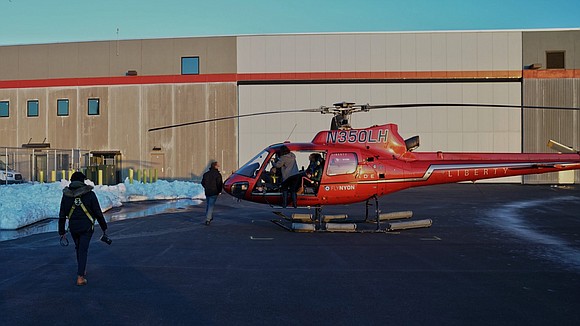NYC helicopter crash puts scrutiny on harnesses in open-door choppers
CNN/Stylemagazine.com Newswire | 3/14/2018, 10:43 a.m.

By Eric Levenson and Paul P. Murphy, CNN
(CNN) -- When emergency workers dove into the frigid waters of New York's East River to reach a downed helicopter on Sunday evening, they found a disturbing scene.
The harnesses meant to keep the passengers safe on the doors-off helicopter flight had turned into death traps.
"One of the most difficult parts of the operation, we're told, is the five people besides the pilot were all tightly harnessed," Fire Department of New York Commissioner Daniel Nigro said.
"So these harnesses had to be cut and removed in order to get these folks off of this helicopter, which was upside-down at the time and completely submerged."
On Tuesday, the Federal Aviation Administration said it is giving "urgent attention" to the use of harnesses specifically for aerial photography flights.
"We are supporting the (National Transportation Safety Board) and we will take appropriation action based on what we learn from the investigation," the FAA said. "As a matter of overall safety awareness, we are preparing further communications and educational outreach to aerial photography operators and consumers on the use of these harnesses."
NTSB investigators are scrutinizing the harnesses as they work to determine how a helicopter ride for a private photo shoot turned into a fatal crash.
The helicopter, with the doors removed so passengers could take unobscured photographs, experienced engine problems and crashed in the East River. Its pontoons did inflate but then it flipped upside down and sank into the water.
The pilot was able to remove himself from the harness and escape, but all five passengers died from accidental drowning, the New York City Office of Chief Medical Examiner said. The New York Police Department identified the victims as Carla Vallejos Blanco, 29; Daniel Thompson, 34; Tristan Hill, 29; Trevor Cadigan, 26; and Brian McDaniel, 26.
Escaping the harness takes practice and expertise, according to Judith Verweijen, who works in the oil and gas industry offshore and flew on a FlyNYON helicopter on Saturday in New York.
"In my opinion, it is nearly impossible for a non-trained passenger to escape," she told CNN.
Simply shocked and outraged
Helicopter crash attorney Gary C. Robb said he has electronically filed a civil lawsuit against the helicopter company and pilot on behalf of Cadigan's parents.
"The family is simply shocked and outraged that their son drowned to death in this manner," Robb said. "Their greatest wish is that this would never happen again, and that is their primary motivation for going forward."
Robb filed the lawsuit in New York County civil court Tuesday. It states Cadigan was killed "as a direct and proximate result of the aforesaid negligence and carelessness."
CNN has reached out to the companies named in the lawsuit.
The National Transportation Safety Board said it recovered electronic devices, including a GoPro camera, which is being sent to its lab in Washington.
Difficulty of removing the harness
The helicopter was owned by Liberty Helicopters. The passengers bought tickets for the flight through FlyNYON, which advertised its harnesses and doors-off helicopter rides earlier in the day Sunday.
Liberty Helicopters posted a statement on its website after the crash, saying it is "focused on supporting the families affected by this tragic accident and on fully cooperating with the FAA and NTSB investigations." It said it was referring all press inquiries to federal agencies.
Marco Christian Slot, who took a FlyNYON trip recently, shared with CNN the short safety demonstration video shown to FlyNYON passengers on March 9.
"In the rare case of an emergency, the harness can be released by opening the quick-release clip in the back of the harness," a voice says over video of the quick-release clip.
"A cutter is also secured to one of your chest straps and will allow you to quickly cut through the harness if you are unable to reach the quick-release clip."
The video shows a curved cutter located on the harness's left shoulder strap being used to cut through a strap connecting the harness to the helicopter.
The entire safety video lasts about three minutes, and only about 20 seconds deal with how to get out of the harness in an emergency.
Eric Adams, another recent passenger on a FlyNYON ride, said he watched the safety demonstration video, but he told CNN he does not remember being told where the cutter was located.
Verweijen, who has trained in HUET, or helicopter underwater escape training, described the difficulties in escaping the harness during an actual emergency.
"You completely lose the orientation. First of all, you have to wait until the copter is underwater to make sure the rotor is stopped. Because of the weight of the engines, you will always be upside down. Then you have to be able to open your safety belt," she said.
"Next, you have to take out a window to escape, doors will be heavy to open. It is dark, cold and you cannot see anything. The pilot could get out because he was trained," she added.
FlyNYON said in a statement on Twitter that it was fully cooperating with the FAA and NTSB investigation.
"NY on Air is terribly saddened to acknowledge that its customers were passengers on the Liberty Helicopters flight that went down in the East River last night," FlyNYON said.
Clarification: This story has been updated to clarify FlyNYON's connection to the flight.






